MSF: Two LTIs – a slip and a fall, and trapping a thumb
The Marine Safety Forum (MSF) have recently released two safety alerts relating to lost time injuries (LTIs). These are Safety Alert 18-27 and Safety Alert 18-24.
Incident 1: fractured toe
A crew member was going to a lower deck using an external stairway. He was holding a bucket in one hand and holding the handrail with the other. As he descended the staircase, his foot slipped off the step, causing him to fall. In order to prevent further slipping down the remaining steps, he put his left foot in the space between the upright stanchions to break the falling motion, and as a result broke his toe.
The weather conditions were dry, and the vessels’ movement was not excessive. The injured person was wearing appropriate footwear.
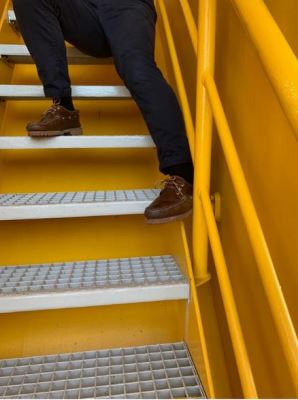
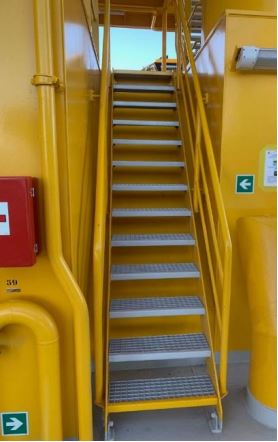
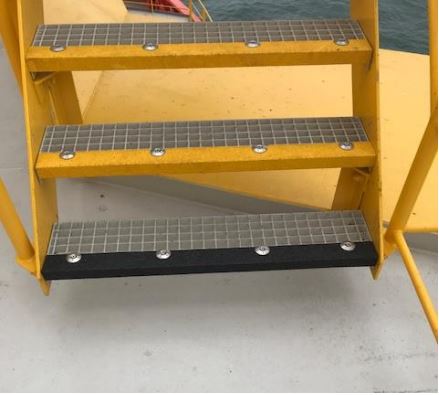
Why did it happen? What were the causes?
The MSF notes that the only potential problem could have been an ineffective grip on the steps; the vessel had the standard perforated steps found on many vessels, however, there was no additional anti-slip grip strip.
What actions were taken?
- Check that the anti-slip design or measures remain fit for purpose, and that they have not been painted over or worn – check it is still effective;
- During wet weather or when decks and surfaces are wet, particular care should be taken to use the ‘trailing hand’ technique or the ‘one hand for the ship and one for yourself’;
- Always wear appropriate personal protective equipment (PPE).
Incident two – squeezed thumb
A crew member was opening a watertight door into the bow thruster room. As he placed his hand on the operating handle, he placed the other hand on the watertight door framework opposite. As the door opened, his thumb was squeezed between the frame plating and the door housing.
What happened?
The injured person placed his hand on the opposite side of the door to steady himself, just in case of vessel movement. However, the framework provides a flat surface and is easily mistaken as a ‘safe spot’ to place a hand when operating the operating lever.
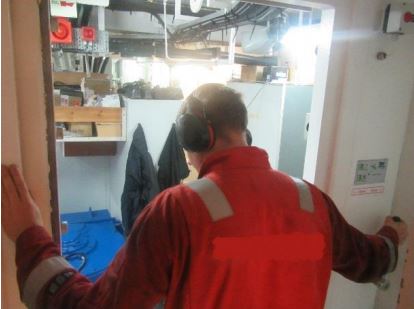

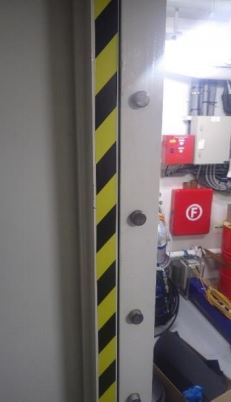
What actions were taken?
- Ensure all new crew members undertake a familiarisation tour of the vessel, effectively highlighting potential hazards (particularly, moving machinery, stored energy situations and equipment etc.);
- Encourage crew members to ask questions if any task or part of their role is not understood;
- All new crewmembers onboard should be supervised – this is key in providing trainees with a safe working environment. All supervisors are encouraged to ensure close mentoring and supervision;
- Highlight hazards surrounding the weather tight and watertight doors onboard;
- Add hazard markings to the door frame (as demonstrated in the above photos);
- Concentrate on the task at hand – concentration is vital in ensuring every crew member departs the vessel in the same condition they joined.
Members may wish to refer to the following incidents:
Safety Event
Published: 18 December 2018
Download: IMCA SF 28/18
IMCA Safety Flashes
Submit a Report
IMCA Safety Flashes summarise key safety matters and incidents, allowing lessons to be more easily learnt for the benefit of all. The effectiveness of the IMCA Safety Flash system depends on Members sharing information and so avoiding repeat incidents. Please consider adding safetyreports@imca-int.com to your internal distribution list for safety alerts or manually submitting information on incidents you consider may be relevant. All information is anonymised or sanitised, as appropriate.
IMCA’s store terms and conditions (https://www.imca-int.com/legal-notices/terms/) apply to all downloads from IMCA’s website, including this document.
IMCA makes every effort to ensure the accuracy and reliability of the data contained in the documents it publishes, but IMCA shall not be liable for any guidance and/or recommendation and/or statement herein contained. The information contained in this document does not fulfil or replace any individual’s or Member's legal, regulatory or other duties or obligations in respect of their operations. Individuals and Members remain solely responsible for the safe, lawful and proper conduct of their operations.
